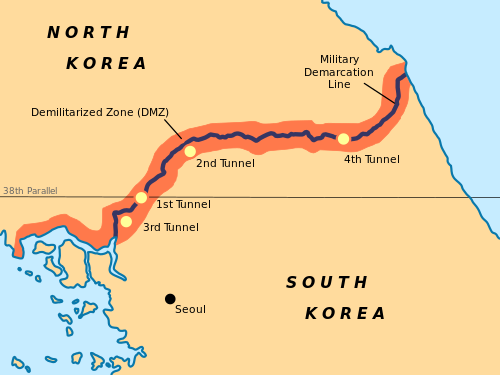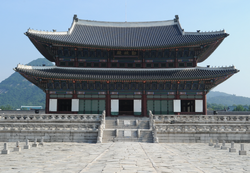

| History of Korea |
|---|
 |
| Timeline |
The division of Korea began at the end of World War II on 2 September 1945, with the establishment of a Soviet occupation zone and a US occupation zone. These zones developed into separate governments, named the Democratic People's Republic of Korea (North Korea) and the Republic of Korea (South Korea), which fought a war from 1950 to 1953. Since then the division has continued.
Contents
- Historical background
- Japanese rule (1910–1945)
- World War II
- Liberation, confusion, and conflict
- Post–World War II
- Division (since 2 September 1945)
- US–Soviet Joint Commission
- UN intervention and the formation of separate governments
- Korean War
- Armistice
- Post-armistice relations
- In popular culture
- Period dramas
- See also
- References
- Further reading
- External links
By the early 20th century, both countries were one single nation: the Korean Empire. During World War II, the Allied leaders had already been considering the question of Korea's future following Japan's eventual surrender in the war. The leaders reached an understanding that Korea would be removed from Japanese control but would be placed under an international trusteeship until the Koreans would be deemed ready for self-rule. [1] In the last days of the war, the United States proposed dividing the Korean peninsula into two occupation zones (a U.S. and Soviet one) with the 38th parallel as the dividing line. The Soviets accepted their proposal and agreed to divide Korea, which led to the declaration of General Order No. 1. [2]
It was understood that this division was only a temporary arrangement until the trusteeship could be implemented. In December 1945, the Moscow Conference of Foreign Ministers resulted in an agreement on a five-year, four-power Korean trusteeship. [3] However, with the onset of the Cold War and other factors both international and domestic, including Korean opposition to the trusteeship, negotiations between the United States and the Soviet Union over the next two years regarding the implementation of the trusteeship failed, thus effectively nullifying the only agreed-upon framework for the re-establishment of an independent and unified Korean state. [1] : 45–154 With this, the Korean question was referred to the United Nations. In 1948, after the UN failed to produce an outcome acceptable to the Soviet Union, UN-supervised elections were held in the US-occupied south only. Syngman Rhee won the election, while Kim Il Sung consolidated his position as the leader of Soviet-occupied northern Korea. This led to the establishment of the Republic of Korea in southern Korea on 15 August 1948, promptly followed by the establishment of the Democratic People's Republic of Korea in northern Korea on 9 September 1948. The United States supported the South, the Soviet Union supported the North, and each government claimed sovereignty over the whole Korean peninsula.
On 25 June 1950, North Korea invaded South Korea in an attempt to re-unify the peninsula under its communist rule. The subsequent Korean War, which lasted from 1950 to 1953, ended with a stalemate and has left Korea divided by the Korean Demilitarized Zone (DMZ) up to the present day.
During the April 2018 inter-Korean summit, the Panmunjom Declaration for Peace, Prosperity and Reunification of the Korean Peninsula was adopted between Kim Jong Un, the Supreme Leader of North Korea, and Moon Jae-in, then President of South Korea. During the September 2018 inter-Korean summit, several actions were taken toward reunification along the border, such as the dismantling of guard posts and the creation of buffer zones to prevent clashes. On 12 December 2018, soldiers from both Koreas crossed the Military Demarcation Line (MDL) into the opposition countries for the first time in history. [4] [5] In following years, dialogue broke down and hostilities resumed.



![Anti-trusteeship Movement [ko] protests in the South (December 1945) Anti-Trusteeship Campaign.jpg](http://upload.wikimedia.org/wikipedia/commons/thumb/f/fe/Anti-Trusteeship_Campaign.jpg/250px-Anti-Trusteeship_Campaign.jpg)
![South Korean demonstration in support of the U.S.-Soviet Joint Commission [ko] in 1946 Demonstration in support of the US-Soviet Joint Commission2.JPG](http://upload.wikimedia.org/wikipedia/commons/thumb/4/41/Demonstration_in_support_of_the_US-Soviet_Joint_Commission2.JPG/250px-Demonstration_in_support_of_the_US-Soviet_Joint_Commission2.JPG)




